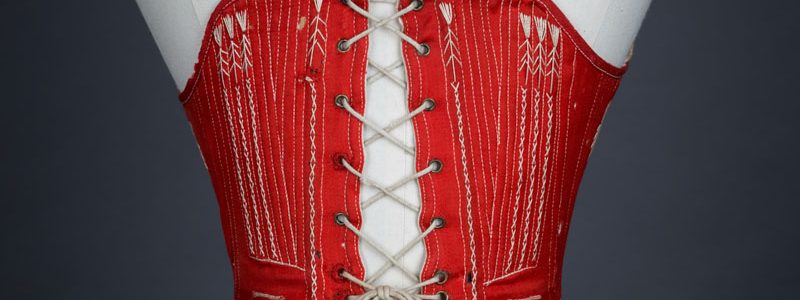#UPMTC: Hold On and Suck In, by Cassidy Percoco
This blog post details the Underpinnings Museum Twitter conference presentation from Cassidy Percoco, entitled Hold On and Suck In: 20th Century Views of the 19th Century Corset.
Since the early twentieth century, ‘modern’ society has been distancing itself from the Victorian era. One of the major methods used has been the mainstreaming of the once-fringe view that wearing corsets was an incredibly dangerous and painful practice done for the purpose of appealing to men. In this presentation, I will explore the ways that this tendency has manifested and how it distorts the actual women who wore corsets on a regular basis in the nineteenth century.
Cassidy Percoco is the author of Regency Women’s Dress: Techniques and Patterns, 1800-1829, and a graduate of the Fashion and Textile History, Theory, & Museum Practice master’s program at the Fashion Institute of Technology. Currently, she runs the blog and podcast A Most Beguiling Accomplishment.
1 #UPMTC One of the most popular images today of the Victorian woman is of her being laced by a maid as she clings to the bedpost – the perfect representation of repression. I’m exploring how this trope was deliberately used to distance “modern” mores from the past! pic.twitter.com/jGU3qdy2Iw
— Cassidy Percoco (@mimicofmodes) January 12, 2018
2 #UPMTC In the early 20th century, opinions on the Victorian era tended to polarize: some were nostalgic for the quaint, “innocent” past (Victorianism), while others saw the period as backward and repressive (anti-Victorianism). One battleground of the latter was the corset.
— Cassidy Percoco (@mimicofmodes) January 12, 2018
3 #UPMTC Historically, corsets were criticized by moralists and physicians, but otherwise taken for granted; in the 19th century, criticisms that *most* corsets were unhealthy were used to market “healthy” ones, a trend that continued into the 20th. pic.twitter.com/rCleIdCG1U
— Cassidy Percoco (@mimicofmodes) January 12, 2018
4 #UPMTC 20th century corset ads made much of the healthiness of their products’ “natural” shape, their flexible boning and elastic material, their “perfect comfort”, and the “scientific” planning that went into them. These were seen as new and better garments. pic.twitter.com/bPRCWMKDRL
— Cassidy Percoco (@mimicofmodes) January 12, 2018
5 #UPMTC The modern woman didn’t care about artificially shrinking her waistline (though she often dieted) and hated the idea of having her body trapped by unyielding whalebone. She was enlightened! She wore a corset – later girdle – for posture, health, and smooth lines. pic.twitter.com/ymxmxssODN
— Cassidy Percoco (@mimicofmodes) January 12, 2018
6 #UPMTC The old-fashioned hourglass corset can be found in plenty of fiction from this period as a freakish oddity representing the oppression women had to put themselves through. Judy Garland’s Esther was debilitated by a corset in Meet Me in St. Louis (1944) … pic.twitter.com/is4bxur0iA
— Cassidy Percoco (@mimicofmodes) January 12, 2018
7 #UPMTC Scarlett O’Hara, the most famous corset-wearer onscreen, was depicted as intent on getting a tiny waist in two separate scenes, fetishistically focusing on the specific measurement and being angry that she couldn’t get down to an 18.5” waist after having given birth. pic.twitter.com/mTWvu2tj16
— Cassidy Percoco (@mimicofmodes) January 12, 2018
8 #UPMTC In Two Weeks with Love (1950), Jane Powell’s Patti’s corset (and lack thereof) is a big plot point. The Tall Men (1955) shows Jane Russell’s Nella transformed from rough settler to fine lady by dressing up with a corset that prevents her from breathing as well. pic.twitter.com/JefdySqslV
— Cassidy Percoco (@mimicofmodes) January 12, 2018
9 #UPMTC The major telling anachronism here is that the corset is treated as something adult women only wear as sexual marketing, choosing to sacrifice breathing for “allure”. To the post-Victorian, it had no place as a piece of supportive underwear worn by most women and girls.
— Cassidy Percoco (@mimicofmodes) January 12, 2018
10 #UPMTC In reality, Patti and Esther would already have been wearing corsets from childhood to promote good posture, and even a country woman like Nella would’ve worn one on an everyday basis. A realistic shift in these scenes would be to a fancier corset or a more shapely one. pic.twitter.com/3pVzLNgCR7
— Cassidy Percoco (@mimicofmodes) January 12, 2018
11 #UPMTC The corset was Othered as a barbarity society had moved past (and also used as commentary on the supposed female tendency to put fashion/appearance before comfort and sense). Contributing to the trope showed that you too were enlightened.
— Cassidy Percoco (@mimicofmodes) January 12, 2018
12 #UPMTC This trend in representation helped to reinforce the view of the corset in the public’s mind, divorced utterly from “normal” shapewear like the girdle/corselet and brassiere, as something dangerous, unnecessary, and sexual – a view that is alive and well today! pic.twitter.com/ma0qmqZ231
— Cassidy Percoco (@mimicofmodes) January 12, 2018
We will share each of the conference presentations via its own blog post over the coming weeks. If you’re on Twitter, you can join the discussion via the Underpinnings Museum’s account and the conference hashtag #UPMTC
The header image for this post is of a red midbust corset with flossing and gores (c.1860s) from the Underpinning Museum collection. Photography by Tigz Rice.
